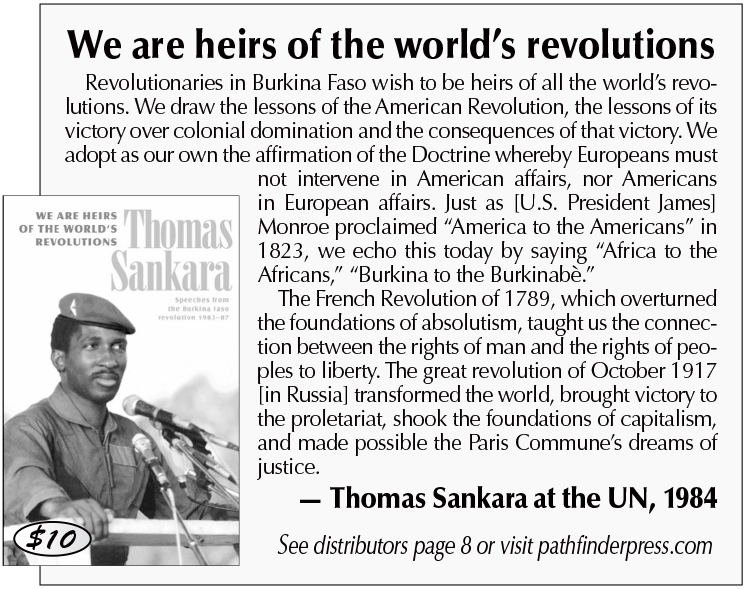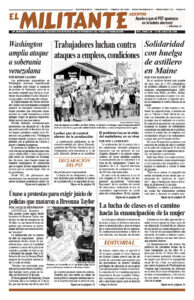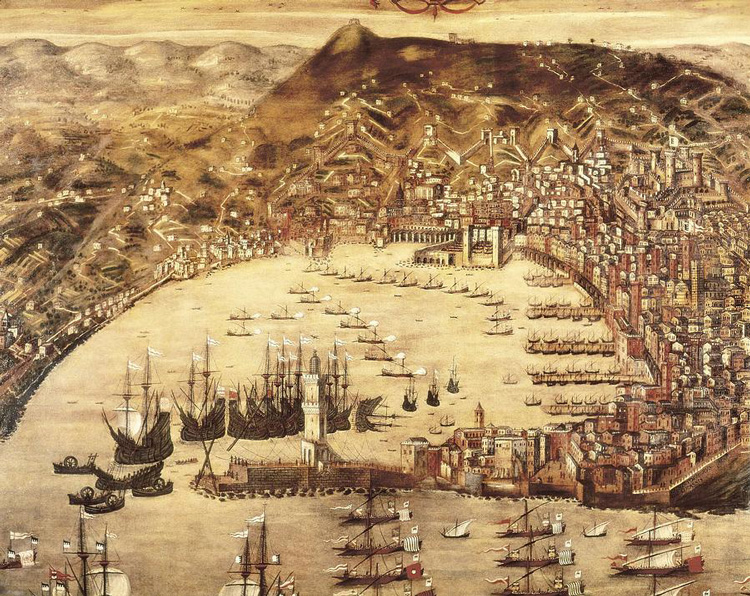The approaching 500th anniversary of the European discovery of the Americas has given rise to a widespread debate on the significance of this event and the colonization of the continent which followed.
In the accompanying interview Cuban minister of culture Armando Hart outlines a materialist approach to this history, explaining the discovery of the Americas as a revolutionary event that “extended human culture into a dimension unknown until that moment.”
The clash between the indigenous societies of the Americas and the social system that was beginning to emerge in Europe in Columbus’s time — capitalism — is discussed in greater depth by George Novack in the article “The Long View of History,” which is contained in his book Understanding History — Marxist Essays, published by Pathfinder.
“American history breaks sharply into two fundamentally different epochs,” writes Novack. “One belongs to the aboriginal inhabitants, the Indians; the other starts with the coming of white Europeans to America at the end of the fifteenth century.”
Novack outlines the level of social development of the Indian societies: “Whoever regards the Indians as insignificant or incompetent has defective historical judgment. Humanity has been raised to its present state by four branches of productive activity. The first is food-gathering, which includes grubbing for roots and berries as well as hunting and fishing. The second is stock-raising. The third is agriculture. The fourth is craftsmanship, graduating into large-scale industry.”
The Indians were skillful at hunting, fishing and other methods of food-gathering, he notes. “They were ingenious craftsmen. … The Incas, for example, made textiles which were extremely fine in texture, coloring and design. They invented and used more different techniques of weaving on their hand looms than any other people in history.
“However, the Indians showed the greatest talent in their development of agriculture. They may even have independently invented soil cultivation.
“We are indebted to the Indians for most of the vegetables that [we have] today. … Most important are corn, potatoes and beans, but there is in addition a considerable list including tomatoes, chili, pineapples, peanuts, avocados, and … tobacco. They knew and used the properties of 400 separate specie of plants. No plant cultivated by the American Indians was known to Asia, Europe or Africa prior to the white invasion of America.
“The introduction of the food plants taken from the Indians more than doubled the available food supply of the older continent after the fifteenth century and became an important factor in the expansion of capitalist civilization. Over half of the agricultural produce raised in the world today comes from plants domesticated by the Indians!
Novack indicates the high peaks of Indian cultures: “The Incas of the Andes, the Mayans of Guatemala and Yucatan, and the Aztecs of central Mexico, unaffected by European civilization and developed independently, constituted the most advanced of the societies. Their cultures embodied the utmost the Indians were able to accomplish within the twenty-five thousand years or so allotted to them by history.”
“In fact, the Mayans had made mathematical and astronomical calculations more complex and advanced than those of the European invaders. They had independently invented the zero for use in their number system — something even the Greeks and Romans had lacked.”
Novack explains that despite these achievements, several major obstacles limited the Indian societies’ ability to advance further. They did not have such important domesticated animals as the horse, cow, pig, sheep or water buffalo that had pulled the Asians and Europeans along toward civilization. “Moreover, they did not use the wheel, except for toys, [and] did not know the use of iron or firearms.”
This stands in contrast with developments in Europe at the time. “While the most advanced Indians had been moving up from wandering hunters’ lives to those of settlers in barbaric communities, the Europeans, themselves an offspring of Asiatic culture, had not only entered class society but had become highly civilized. Their most progressive segments along the Atlantic seaboard were passing over from feudalism to capitalism.”
Novack looks more closely at the “incompatible levels of social organization” as the “root cause of the enduring and deadly clash” between the Indian and the European societies:
“Even at its height, Indian life was based upon tribal collectivism and its crude technology. The Indians not only did not have the wheel, iron or the alphabet — they also lacked the institutions, ideas, feelings and aims of civilized peoples who had been molded by the technology and culture of an acquisitive society.
“These conditions had stamped out a very special kind of human being as the peculiar product of civilization based on private ownership [to whom] it appeared natural and necessary … that almost everything on earth should pass into someone’s private ownership. Clothes, houses, weapons of war, tools, ships, even human beings themselves, could be bought and sold.”
“The doctrine of the European whites was that everything must have its price,” Novack writes, “whether it pertains to present happiness or future salvation. This idea remains the guideline for the plutocratic rulers of our day who in their campaigns to dominate the world not only buy up individuals but even whole governments. In their quest for gold and lust for gain, Columbus and the Conquistadors enslaved and killed thousands of West Indians in the islands they discovered. And that was only the beginning.”
European society was passing from feudalism to capitalism at the time of Columbus. This was not a smooth process, but was accompanied by violent conflicts as the forces of feudalism on the one side and the rising capitalist class on the other wrestled for supremacy.
As Armando Hart notes, one paradoxical result of the Spanish monarchy’s success in colonizing and plundering central and south America was that the development of Spain itself was held back for centuries, while other European nations overtook and displaced Spain as pre-eminent world powers.
The opening of the Americas to European trade and colonization was decisive in those nations for capitalist development, a central part of which was the process Karl Marx called “primitive accumulation” of capital. He described what this entailed in “The Genesis of the Industrial Capitalist”: [Capital, Volume I, Chapter 31. Vintage Books, New York, 1977.]
“The discovery of gold and silver in America, the extirpation, enslavement and entombment in mines of the indigenous population of that continent, the beginnings of the conquest and plunder of India, and the conversion of Africa into a preserve for the commercial hunting of black skins, are all things which characterize the dawn of the era of capitalist production. These idyllic proceedings are the chief moments of primitive accumulation.”
Outlining the history of European colonial plunder throughout the world, Marx comments, “The treatment of the indigenous population was, of course, at its most frightful in plantation-colonies set up exclusively for the export trade, such as the West Indies, and in rich and well-populated countries, such as Mexico and India, that were given over to plunder.
“The colonial system ripened trade and navigation as in a hothouse,” Marx explains. “The colonies provided a market for the budding manufactures, and a vast increase in accumulation which was guaranteed by the mother country’s monopoly of the market. The treasures captured outside Europe by undisguised looting, enslavement and murder flowed back to the mother-country and were turned into capital there.

“The veiled slavery of the wage labourers in Europe,” Marx concludes, “needed the unqualified slavery of the New World as its pedestal.” All this was necessary “to unleash the ‘eternal natural laws’ of the capitalist mode of production, to complete the process of separation between the workers and the conditions of their labour, to transform, at one pole, the social means of production and subsistence into capital, and at the opposite pole, the mass of the population into wage-labourers, into the free ‘laboring poor’, that artificial product of modern history.
“If money, according to Augier, ‘comes into the world with a congenital blood-stain on one cheek,’ capital comes dripping from head to toe, from every pore, with blood and dirt.”


